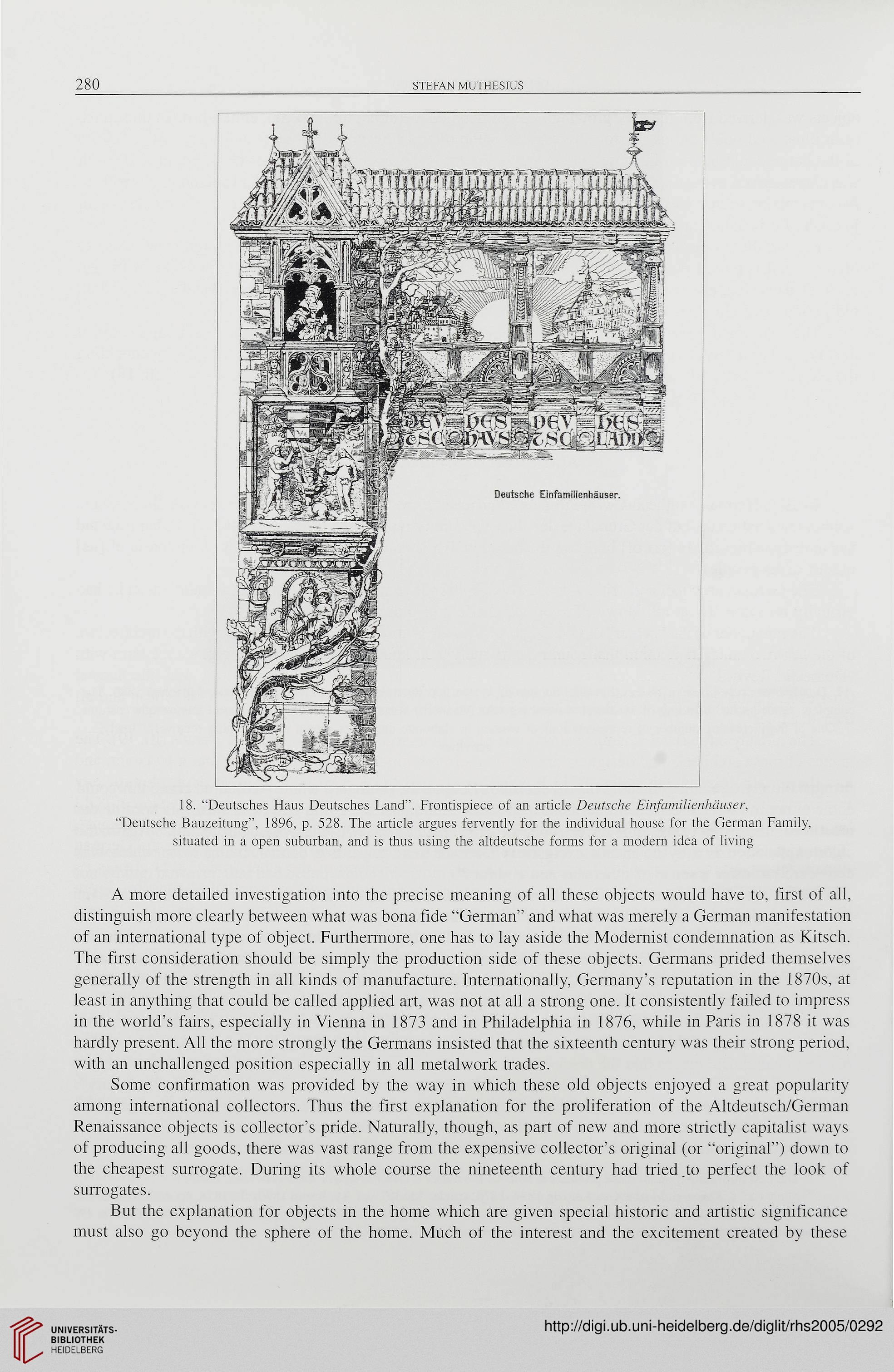280
STEFAN MUTHESIUS
18. "Deutsches Haus Deutsches Land". Frontispiece of an article Deutsche Einfamilienhâuser,
"Deutsche Bauzeitung", 1896, p. 528. The article argues fervently for the individual house for the German Family,
situated in a open suburban, and is thus using the altdeutsche forms for a modern idea of living
A more detailed investigation into the précise meaning of ail thèse objects would have to. first of all,
distinguish more clearly between what was bona fide "German" and what was merely a German manifestation
of an international type of object. Furthermore, one has to lay aside the Modernist condemnation as Kitsch.
The first considération should be simply the production side of these objects. Germans prided themselves
generally of the strength in all kinds of manufacture. Internationally, Germany's réputation in the 1870s. at
least in anything that could be called applied art, was not at all a strong one. It consistently failed to impress
in the world's fairs, especially in Vienna in 1873 and in Philadelphia in 1876, while in Paris in 1878 it was
hardly présent. All the more strongly the Germans insisted that the sixteenth century was their strong period,
with an unchallenged position especially in all metalwork trades.
Some confirmation was provided by the way in which these old objects enjoyed a great popularity
among international collectors. Thus the first explanation for the prolifération of the Altdeutsch/German
Renaissance objects is collector's pride. Naturally, though, as part of new and more strictly capitalist ways
of producing all goods, there was vast range from the expensive collector's original (or "original"") down to
the cheapest surrogate. During its whole course the nineteenth century had tried.to perfect the look of
surrogates.
But the explanation for objects in the home which are given spécial historie and artistic significance
must also go beyond the sphère of the home. Much of the interest and the excitement created by these
STEFAN MUTHESIUS
18. "Deutsches Haus Deutsches Land". Frontispiece of an article Deutsche Einfamilienhâuser,
"Deutsche Bauzeitung", 1896, p. 528. The article argues fervently for the individual house for the German Family,
situated in a open suburban, and is thus using the altdeutsche forms for a modern idea of living
A more detailed investigation into the précise meaning of ail thèse objects would have to. first of all,
distinguish more clearly between what was bona fide "German" and what was merely a German manifestation
of an international type of object. Furthermore, one has to lay aside the Modernist condemnation as Kitsch.
The first considération should be simply the production side of these objects. Germans prided themselves
generally of the strength in all kinds of manufacture. Internationally, Germany's réputation in the 1870s. at
least in anything that could be called applied art, was not at all a strong one. It consistently failed to impress
in the world's fairs, especially in Vienna in 1873 and in Philadelphia in 1876, while in Paris in 1878 it was
hardly présent. All the more strongly the Germans insisted that the sixteenth century was their strong period,
with an unchallenged position especially in all metalwork trades.
Some confirmation was provided by the way in which these old objects enjoyed a great popularity
among international collectors. Thus the first explanation for the prolifération of the Altdeutsch/German
Renaissance objects is collector's pride. Naturally, though, as part of new and more strictly capitalist ways
of producing all goods, there was vast range from the expensive collector's original (or "original"") down to
the cheapest surrogate. During its whole course the nineteenth century had tried.to perfect the look of
surrogates.
But the explanation for objects in the home which are given spécial historie and artistic significance
must also go beyond the sphère of the home. Much of the interest and the excitement created by these




